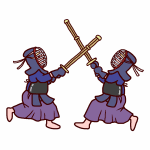Japanese sports

Japanese sports |
 |
Sumo, Judo and Kendo |
TOP > Japanese sports
Japanese sportsNowadays, the sports imported from western countries like baseball and association football are popular in Japan, but also traditional Japanese sports have been succeeded. Among them, I will introduce Sumo, Judo and Kendo in this page. Sumo Sumo (Sumo wrestling) is a fighting sports played by 2 wrestlers who wear only special belt called Mawashi. If one wrestler pushes another wrestler out of the circle (called Dohyo) or touches another's any parts of the body except sole to the ground, he will be the winner. It has been performed since ancient times according to Shintoism, so it is more like a religious ritual than sport. So, other than Ozumo (Grand Sumo Tournament) by professional wrestlers, it is performed during Shinto shrine festival as praying peace, good harvest and good catch of fish in many regions of Japan.  Because of this chrastristics, the tournament starts with the ritual the day before and each action by the wrestler has meaning and courtesy is respected. For example, Shiko (raise highly one foot and stamp down) is to remove the evil spirits. And the roof above Sumo ring models the Shinto Shrine. Professional Sumo wrestler has appeared during Edo era (17-19the century). Now, Grand Sumo Tournaments by the professional are held 6 times a year (January, May, September in Tokyo Ryogoku Kokugikan; March in Osaka; July in Nagoya; November in Fukuoka). One tournament lasts 15 days. The wrestler who wins the most will be the champion. There is no classification by the weight like Judo and wrestling. Judo  Judo is a fighting sports (martial art) performed on tatami (straw mat) floor. Player wins when he throws opponent on his back (Nagewaza) or grapples (Katamewaza). By the strength and speed of Nagewaza and duration of Katamewaza, he will be judged either 'Ippon', 'Wazaari' or 'Yuko'. If one gets 'Ippon', he wins. If one gets 2 'Wazaari', it is regarded as 'Ippon'. The origine is said to be in ancient times, but actually Jigoro Kano founded Judo at Kodokan in 1882 from Jujutsu of Edo era. Winning is not the only goal but the basic ideas are making good use of energy and mutual prosperity. Its aim is to train body and spirit. Judo has become official Olympic event since Tokyo Olympic in 1964, and become international sport performed in more than 200 countries. Kendo  Kendo is a fighting sports (martial art) perfomed on wooden floor with bare foot. The player wears protective gear and use bamboo sword. He tries to hit or tilt opponent's protective gear (forearm, throat cover, hear or trunk) with bamboo sword. Iyou hit or tilt with full enthusiasm and right form, you will get 'Ippon'. You will win with 2 Ippon. Kenjutsu has developed as ancient Japanese martial art, but when they practice, they became to use bamboo instead of sword. In Edo era, they started to use divided bamboo sword like we use today to practice safely. The practice using bamboo sword developed to competition and has become Kendo. Kendo is not only a competition but the martial art to train body and spirit through the practice, and also for character formation. Other sports Followings are some other Japanese traditional sports. - Karate: Martial art, defeating opponent by hand and foot. - Aikido: Martial art, drawing down, throwing or grappling opponent by making use of opponent's weakness of joints. - Kyudo: Japanese archery for training body and spirit through each movement. - Iaido: Through the movement from drawing to putting up the sword, training techinique, body and spirit. |
Sumo in Edo era (wall painting of Sumo Museum) |
| Copyright(C) Let's Travel in Japan ! All Rights Reserved |